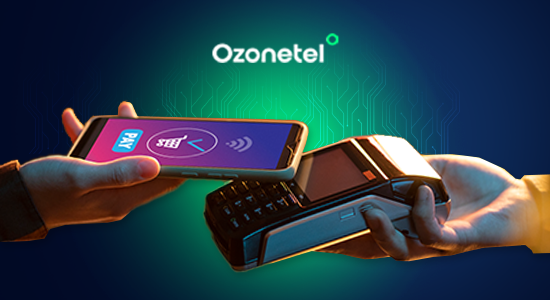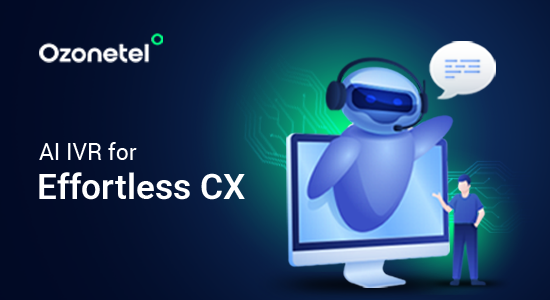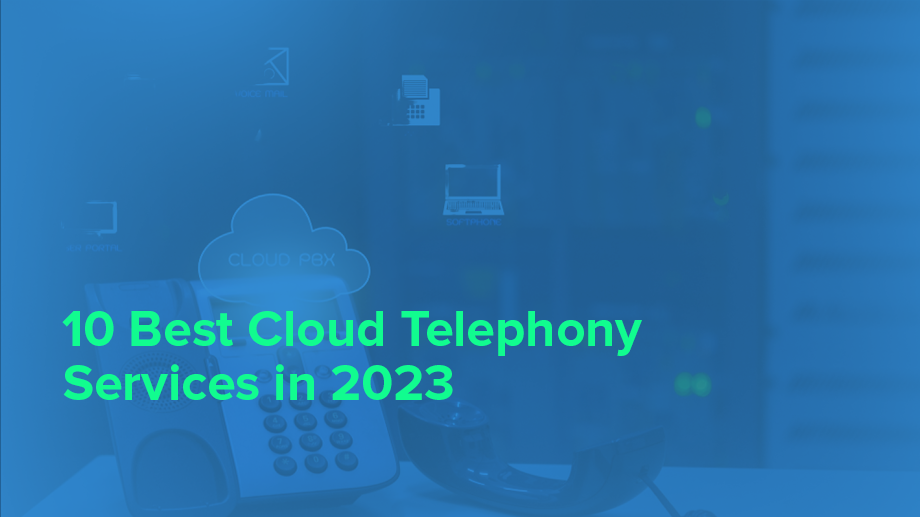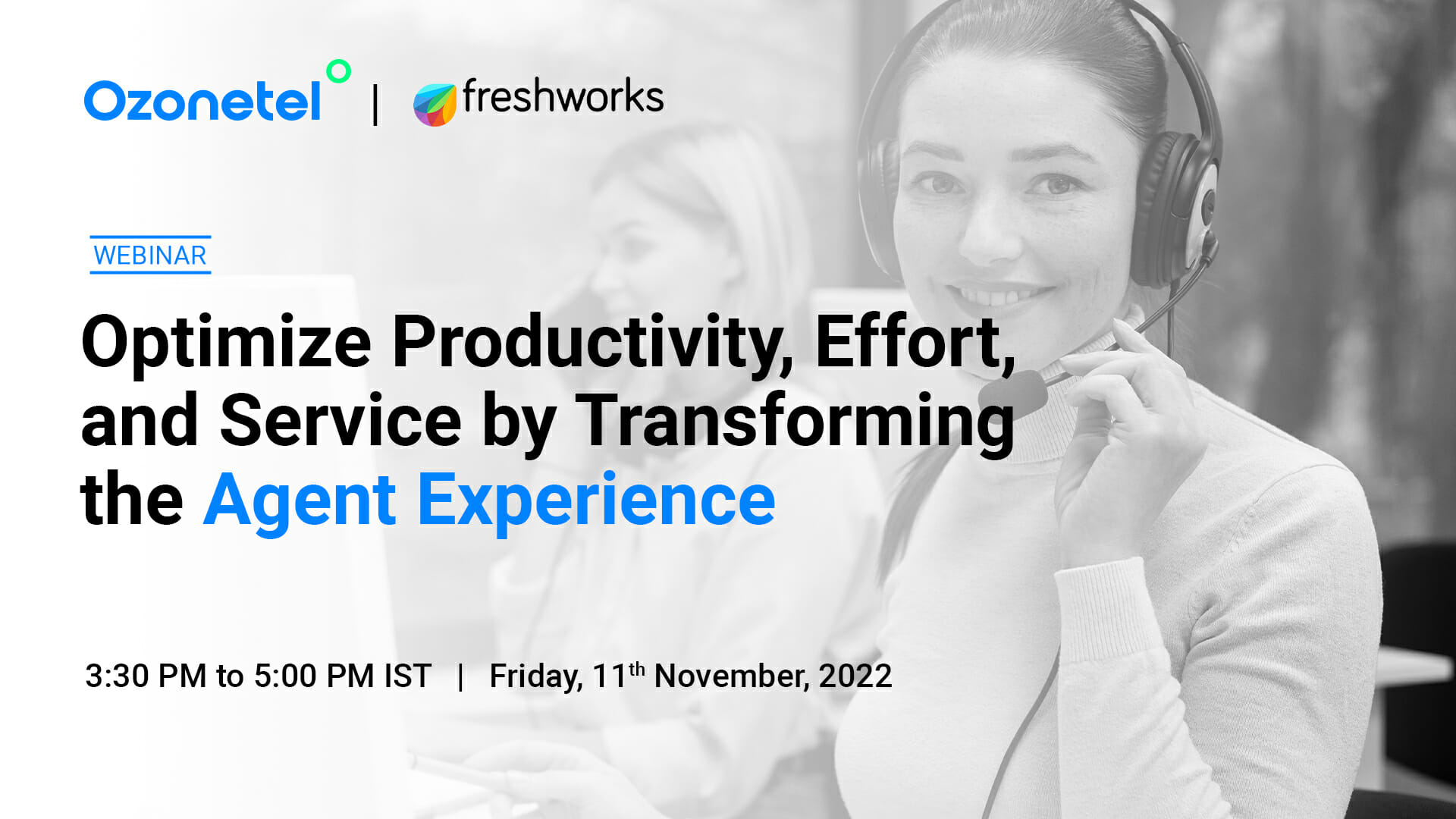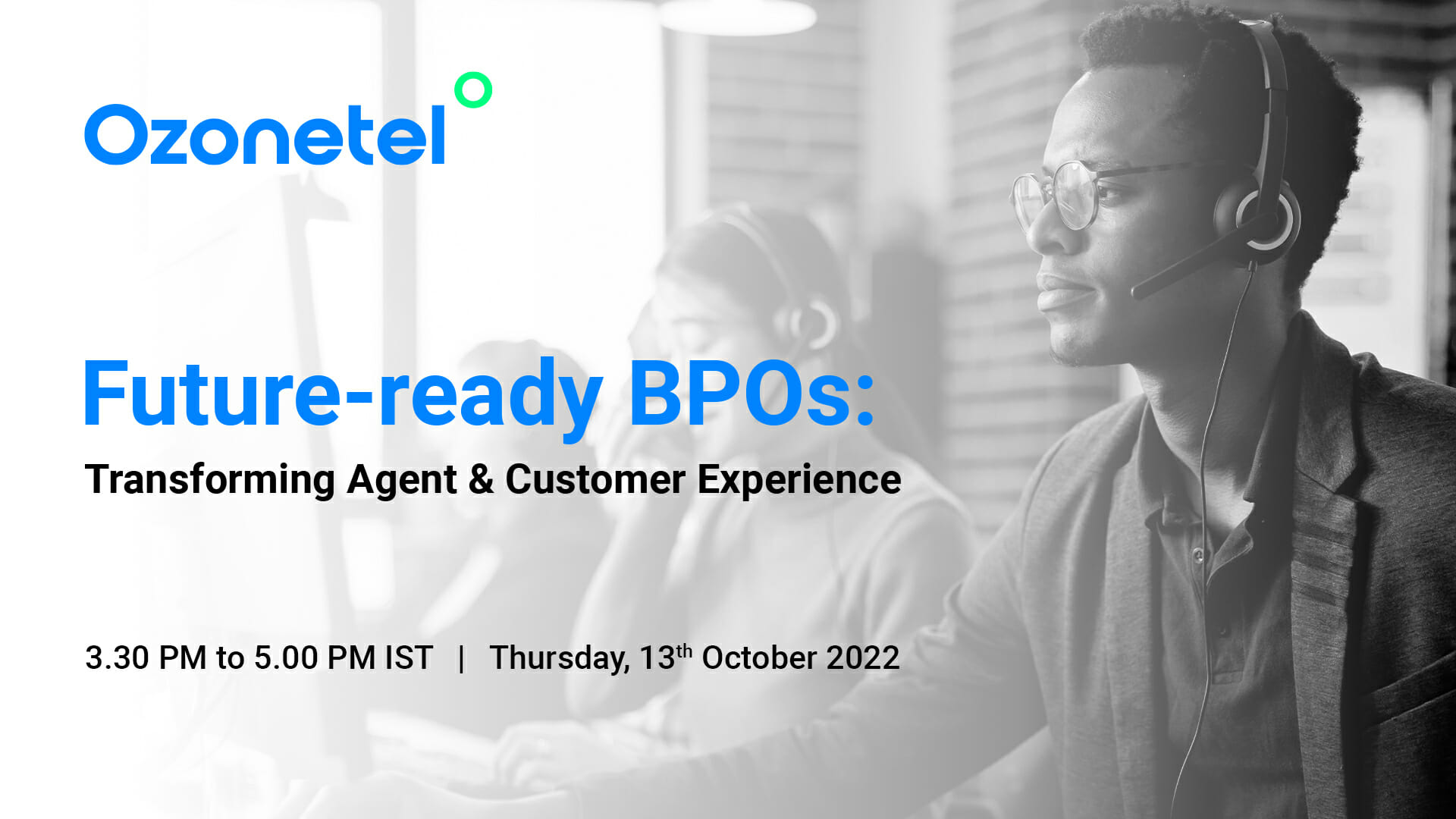- Resources
- What is a Cloud Contact Center? A Complete Guide
What is a Cloud Contact Center? A Complete Guide

Imagine a customer needing urgent support—calling your helpline, chatting on WhatsApp, and tweeting at your brand—all within minutes. Your agents are spread across locations, but your legacy system can’t keep up. Calls drop, queries get missed, and there’s zero visibility.
This is exactly where a cloud contact center transforms the game—offering real-time coordination, unified communication, and total control, no matter where your teams or customers are.
In this article, we will explore:
- 1.What Is a Cloud Contact Center?
- 2. What Is Cloud Contact Center Software?
- 3.How Does a Cloud Contact Center Work?
- 4.Cloud Contact Center vs On-Premise Contact Center
- 5.How to Migrate from On-Premise to Cloud Contact Center
- 6.Cloud Contact Center vs Cloud Call Center
- 7.Features of a Modern Cloud Contact Center
- 8.Business Benefits of Cloud Contact Centers
- 9.How Cloud Contact Centers Improve Customer Experience (CX)
- 10.How to Choose the Right Contact Center Provider
- 11.Industry-Specific Use Cases
- 12.Why Ozonetel is a Leading Cloud Contact Center Platform
What is Employee Experience?
Employee Experience (EX) is the overall perception employees have of their journey within an organization. It encompasses every interaction and touchpoint, from recruitment and onboarding to daily responsibilities, support systems, and eventual offboarding.
What Is a Cloud Contact Center?
A cloud contact center is a customer service platform that runs entirely over the Internet. It doesn’t require the installation or maintenance of physical hardware or complex phone systems in your office.
Instead, everything—from calls and chats to emails and social media messages—is managed through software hosted online by a third-party service provider.
With a cloud contact center, your team can handle customer conversations across different channels from one place. This includes:
● Voice calls (inbound and outbound)
● Emails
● Web chats
● Social media messages
● SMS (text messages)
What Is Cloud Contact Center Software?
Cloud contact center software is the technology that powers your cloud contact center. It’s the online platform your agents use to handle customer interactions and the system your supervisors use to monitor performance.
You usually pay for this software on a subscription basis, based on usage or the number of users. This makes it easy to manage costs, especially if your call volumes fluctuate during the year.
How Does a Cloud Contact Center Work?
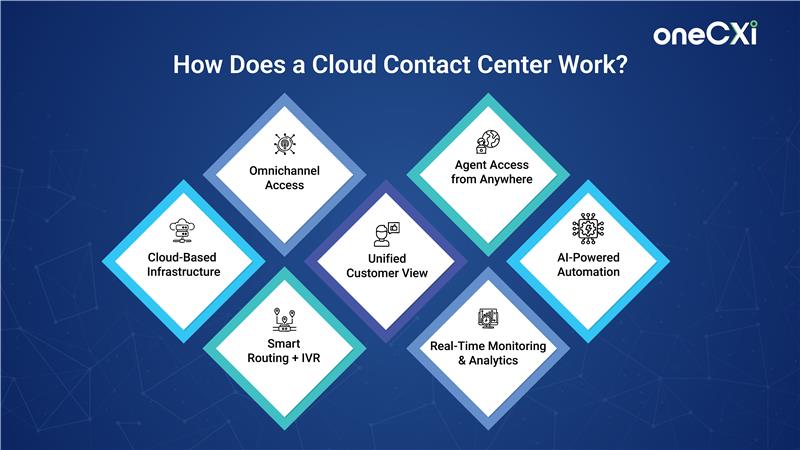
A cloud contact center runs on remote servers managed by your software provider. You access the entire system through a secure internet connection—no on-site hardware or phone systems needed.
Here’s how it typically works:
- Infrastructure and Access: Your provider hosts everything in the cloud. You just need internet-connected devices (computers, headsets, phones). Agents log into the software from anywhere and start taking calls or messages immediately.
- Call and Message Routing: The software automatically routes each customer interaction to the right agent based on rules you set. For example, if someone calls for technical support, the system can skip sales agents and connect them directly to the support team.
- IVR for Self-Service: IVR software helps customers get quick answers through a menu without waiting for an agent. For instance, a caller can press “1” to check their account balance or “2” to speak to billing, before even talking to a human.
- CRM and Context Sync: The system links to your CRM so agents can see a customer’s history, recent purchases, or past issues as soon as they pick up the call. This saves time and helps deliver faster, more personalized support.
- Multi-Channel Conversations: The platform keeps voice, email, chat, and social media conversations in one place. This means if a customer first sends a message on Instagram and later calls your support line, the agent will have full context.
- Monitoring and Analytics: Supervisors can monitor live calls, track performance, and review customer sentiment. You get detailed reports on things like call wait times, agent productivity, and common issues. This helps you identify where things are working and where they aren’t.
- Scalability and Flexibility: Because the system runs in the cloud, you can quickly adjust capacity. Need to add 20 agents during the holidays? You can do that without upgrading any hardware. Want to launch a new support channel like WhatsApp? Most cloud platforms make this easy to switch on.
Cloud Contact Center vs On-Premise Contact Center
Choosing between a cloud contact center and an on-premise contact center is one of the most important decisions you’ll make while setting up or upgrading your support operations. While both models help you manage customer interactions, the way they work, and the impact they have on your team, flexibility, cost, and business agility can be very different. Here’s how:| Factor | Cloud Contact Center | On-Premise Contact Center |
|---|---|---|
| Deployment | Hosted on external servers and accessed via the internet. No need to manage physical infrastructure. | Installed on your company’s servers. Requires setup, maintenance, and physical space. |
| Setup Time | Quick setup—often ready in days. Vendors handle configurations and updates. | Setup can take weeks or months. Requires manual installation and integration. |
| Cost Structure | Subscription-based (OPEX). Pay per user/usage. Low upfront cost. | High upfront CAPEX for hardware, licenses, and maintenance. |
| Scalability | Easy to scale up/down. Add/remove users without major changes. | Scaling requires new hardware, licenses, and support. Often expensive. |
| Security and Compliance | Built-in compliance (e.g., PCI-DSS, HIPAA, GDPR). Audits managed externally. | Requires internal management of all security and compliance standards. |
| Integration with Other Tools | Easy integration with CRMs and SaaS tools via APIs. | More complex integration. May require custom development. |
| Analytics and Reporting | Real-time dashboards and AI-based insights built-in. Accessible anywhere. | Limited reporting. Real-time insights may need extra tools. |
| Vendor Lock-in | Easier to switch vendors. No physical infrastructure dependency. | Hard to migrate. Tied to existing hardware/software stack. |
How to Migrate from On-Premise to Cloud Contact Center
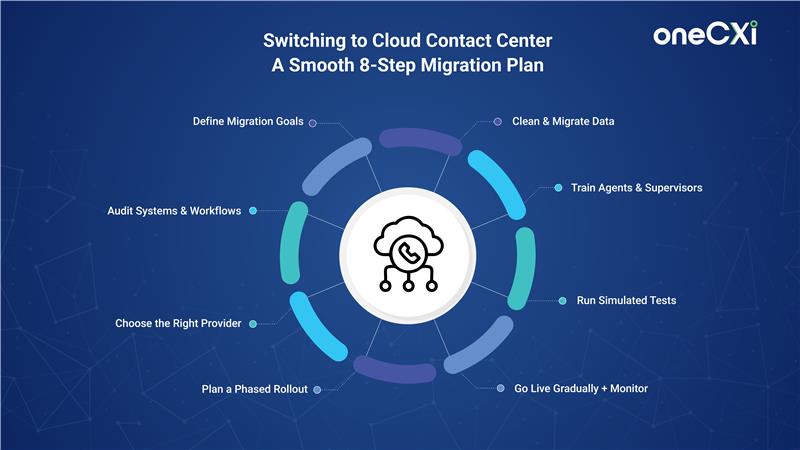
Here’s a detailed, step-by-step guide to help you migrate your contact center without losing operational control or customer satisfaction.
1. Understand Your Goals Clearly
Start by defining why you want to move to the cloud. The reasons should go beyond vague ideas like “improve service.” Think specifically about what problems you want to solve or opportunities you want to capture. For example:
- Do you want to connect your global teams into one platform?
- Are you looking to handle seasonal customer spikes without buying extra hardware?
- Do you want to add AI tools for better routing or faster resolutions?
- Do you need to meet regulatory compliance in multiple regions at lower costs?
Talk to everyone involved—IT, frontline agents, managers, compliance officers—to ensure your goals reflect real operational needs. This clarity will shape the rest of your migration decisions.
2. Audit Your Current Systems and Processes
Perform a thorough review of your existing contact center setup. Look at:
- Hardware and software that are outdated or no longer needed.
- Workflows where agents spend too much time switching tools or gathering customer information.
- Data quality—clean up or reformat customer records and interaction histories before migration.
3. Select a Cloud Contact Center Provider with Proven Expertise
Not all cloud providers offer the same support for migration. Choose one with a clear, scalable approach designed for complex moves. Key things to check:
- Do they have a step-by-step implementation plan covering risk management?
- Can they show real enterprise case studies or references proving successful migrations?
- Will their solution seamlessly integrate with your existing tools, such as CRMs (customer relationship management software) and workforce management?
4. Develop a Phased Migration Plan
Avoid moving everything at once. Instead, break the migration into smaller, manageable parts. For example:
- Start with migrating voice calls in one region or department.
- Then add other channels like chat, email, and social media across global teams.
- Finally, introduce AI-powered tools and advanced analytics.
5. Prepare and Migrate Your Data Carefully
Data migration is critical and complex. Classify your data into:
- Operational data, like customer profiles and call histories.
- Analytics data, such as past performance reports.
- Compliance-sensitive data, which might be subject to laws about storage and transfer.
6. Train Your Team Early and Thoroughly
The new system is only as effective as the people who use it. Start training agents and supervisors before migration completes. Focus on:
- How the cloud system improves their workflow by giving them full customer histories in one place.
- How supervisors can use real-time reports to manage the team better.
- Specialized training for agents in regulated industries like finance or healthcare.
7. Test the System Under Realistic Conditions
Before making the full switch, run tests that simulate everyday challenges:
- High call volume during peak seasons.
- Multichannel customer contacts—voice, chat, social media—are handled simultaneously.
- Recovery procedures after network or server failures.
Include input from IT, operations, compliance, and customer service teams to catch problems early.
8. Launch Gradually with Strong Support in Place
Begin with a soft launch: move a small group of agents or one site to the cloud first. Monitor how the system performs and gather feedback. Quickly address any issues before expanding to other teams or locations.
Set up a solid support structure with your provider and internal IT ready to act fast. Define escalation steps clearly to keep disruptions minimal during the switch.
Cloud Contact Center vs Cloud Call Center
While both cloud contact center and a cloud call center are hosted on the cloud and offer flexibility, they are designed for different types of communication. If you’re trying to scale support, reduce manual work, or improve customer satisfaction, it’s important to understand where each one fits. Here’s a detailed breakdown to help you decide:| Factor | Cloud Contact Center | Cloud Call Center |
|---|---|---|
| Primary Purpose | Designed to manage multichannel customer interactions—voice, email, chat, social media, and more. | Built mainly for handling voice calls—inbound and outbound. |
| Communication Channels | Supports multiple channels from a single interface. Customers can switch from a call to chat or email without starting over. | Only supports phone calls. No native support for chat, email, or other digital channels. |
| Customer Experience | Customers can reach out on their preferred channels. Interactions are consistent and context-aware. | Customer experience is limited to voice. If a customer follows up on another channel, agents may not have previous context. |
| CRM and Tool Integration | Deep integrations with CRM systems, helpdesks, and ticketing tools. Offers a unified view of the customer. | Integrates with basic CRM tools but is often limited to storing call logs or notes. |
| Reporting and Analytics | Provides insights across channels—response time, resolution time, agent performance, and more. | Focuses mainly on call metrics like call volume, wait time, and call duration. |
| Scalability | Highly scalable—add new channels, agents, or features as needed. | Scales easily for voice, but is not built for expanding into multichannel support. |
| Cost | May have a higher monthly fee, but offers more functionality and long-term value. | Generally cheaper upfront, but may require add-ons or third-party tools as you grow. |
Features of a Modern Cloud Contact Center
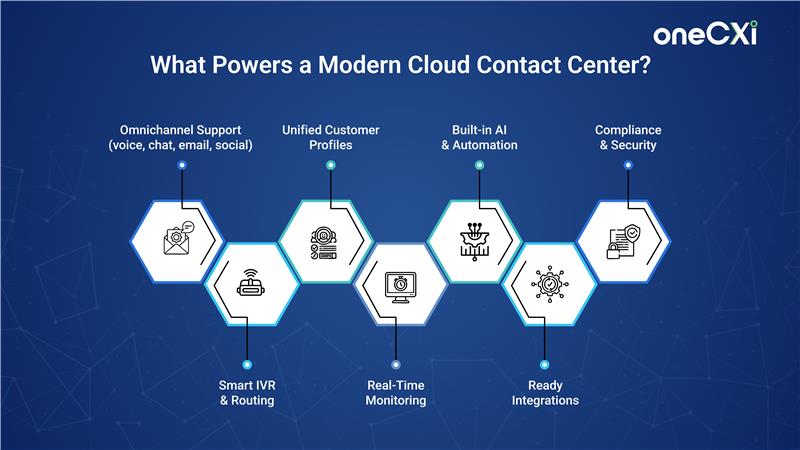
If you’re looking to handle customer interactions efficiently, a modern cloud contact center gives your team the tools to manage high volumes without losing track of quality or speed. Here’s what it should offer:
Omnichannel Support
You can interact with your customers across voice, email, chat, social media, and messaging apps — all from one place. No more jumping between tabs or tools. Your agents can respond faster, stay in context, and maintain a consistent experience, no matter where the customer reaches out.
Smart Routing and IVR (Interactive Voice Response)
Calls and chats automatically go to the right agent based on the customer’s need, the agent’s skill, and availability. IVR menus let customers choose the right department or even resolve simple queries themselves without waiting.
Unified Customer Profiles
A cloud contact center combines data from different systems, like your CRM (Customer Relationship Management), billing software, or helpdesk, into one complete view. Your agents get full context: purchase history, past issues, preferences, and more.
Real-Time Monitoring and Historical Reports
Supervisors can monitor calls and messages live, see how agents are doing, and make quick adjustments. You can also pull detailed reports to analyze trends, agent performance, and customer behavior over time.
Built-in Apps and Integrations
Modern platforms come ready to connect with your CRM, email tools, payment systems, or marketing software. You don’t need to stitch together separate tools.
Security and Compliance
Cloud contact centers apply strong security measures — like data encryption, access controls, regular updates, and backups — to protect customer data and meet legal standards such as PCI (for payments) or HIPAA (for healthcare).
Business Benefits of Cloud Contact Centers
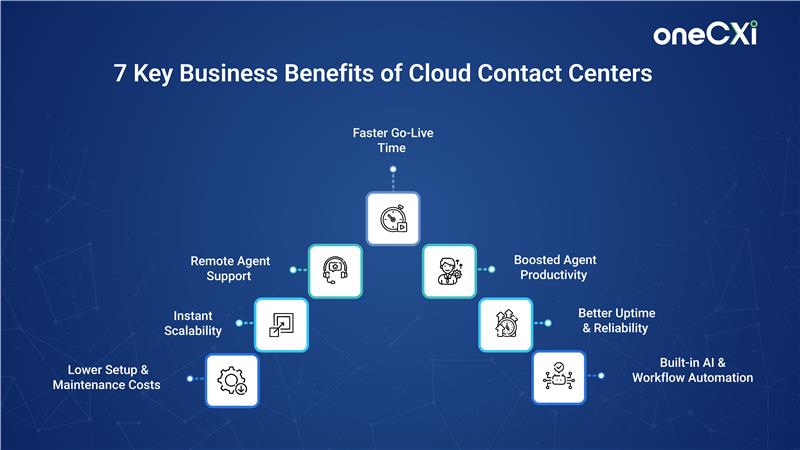
Switching to a cloud contact center is more than just moving to a new tool. It can change how your customer support runs with real, measurable impact. Here’s how:
1. Lower Costs (Setup and Ongoing)
You don’t need to buy servers, hardware, or pay for physical space. The cloud provider handles updates, maintenance, and security. You pay only for what you use.
What it means for you: You save on infrastructure, reduce IT overhead, and can run leaner operations without sacrificing quality.
2. Easy Scalability
Need to add 50 agents during a busy season? Or scale down after a rush? You can do it instantly through the cloud platform — no installation, no logistics.
What it means for you: You only pay for the resources you need, when you need them. No long-term commitments or wasted capacity.
3. Remote-Friendly
Agents and supervisors can work from anywhere with an internet connection. It supports flexible work models and access to a wider talent pool.
What it means for you: You’re not limited by geography. It also improves business continuity — if your office is down, your contact center still runs.
4. Fast Setup
You can go live in days, not months. There’s no need for complex hardware or software installations. Settings, routing rules, dashboards — everything is configured through a web interface.
What it means for you: Faster go-to-market for support teams and quicker ROI.
5. Better Agent Productivity
Agents get everything in one place — no switching tabs or digging through spreadsheets. Features like click-to-call, knowledge base access, and smart suggestions help them respond faster and better.
What it means for you: Happier agents, fewer mistakes, and faster resolutions.
CTA: https://ozonetel.com/webinars/optimize-productivity-effort-service-by-transforming-the-agent-experience/
6. Reliable Uptime
Most providers run their systems in multiple secure locations. Even if one server goes down, another picks up the load.
What it means for you: Less downtime and better customer service continuity during outages or spikes.
7. Built-In AI and Automation
AI tools can handle repetitive tasks like FAQs or routing, while your human agents focus on complex problems. Natural Language Processing (NLP) helps systems better understand customer intent.
What it means for you: More efficient operations and better use of human talent.
How Cloud Contact Centers Improve Customer Experience (CX)
If you’re looking to serve customers faster, more accurately, and across multiple channels—without increasing your overhead—a cloud contact center can help. Here’s how it directly improves your customer service operations.
1. You can easily scale up or down
When customer demand increases—say during a sale, festive period, or product launch—you can add more agents without needing to buy new hardware or set up new infrastructure. Similarly, you can scale back when demand drops. This flexibility helps you keep wait times low and service consistent, even during high-traffic periods.
What this means for you:
- Faster response during peak times
- No downtime or lag due to infrastructure constraints
- Smooth customer experience even during spikes
2. You get full visibility into ongoing conversations
Cloud systems allow you to monitor live calls, chats, and messages across channels. You can see what’s working and what’s not while it’s happening, not after the fact.
This helps you:
- Spot bottlenecks in real-time
- Identify training needs early
- Step in to support agents during tough calls
3. Your agents become more productive
Agents have everything they need on one screen—customer history, previous interactions, notes, and relevant resources. That means fewer clicks, less toggling, and faster resolution.
Why it matters:
- New agents get up to speed quicker
- Customers don’t need to repeat information
- Faster issue handling with fewer errors
Also, agents can work from anywhere as long as they have the internet. This gives you access to a wider talent pool and keeps your team flexible.
4. You can personalize every interaction
Cloud contact centers pull data from different systems and tools. This helps you create a complete customer profile—including purchase history, past support tickets, and preferences.
This allows you to:
- Offer context-specific help
- Reduce frustration caused by repetition
- Build trust with every interaction
5. You can automate repetitive tasks
Simple queries like order status, password reset, or store hours don’t need an agent. With built-in automation and bots, you can handle these without human involvement.
This gives you:
- Faster resolutions for common questions
- More time for agents to handle complex issues
- Lower operational costs without impacting service
6. You get detailed reports to improve service
Cloud platforms offer real-time and historical data on things like:
- First response time
- Resolution rate
- Agent performance
- CSAT (Customer Satisfaction Score)
With this data, you can find out what’s slowing things down and fix it before it affects customer satisfaction.
How to Choose the Right Contact Center Provider
Not all cloud contact centers are built the same. To make the right choice, you need to dig deeper into what they actually offer, not just what’s on their feature list.
1. Always try it before you commit
If a provider offers a free trial, use it. This isn’t just about clicking around—it’s your chance to see:
- How easy it is to set up and use
- Whether your agents are comfortable using it
- If it fits into your workflow or needs custom workarounds
What to check during the trial:
- Is the interface cluttered or simple?
- Can agents find what they need quickly?
- Are important features behind paywalls?
If the trial feels frustrating, your team will feel the same after purchase.
2. Pick a platform that helps agents, not just customers
Your customer service depends heavily on how easy your agents’ work is. If the system is too complex or slow, it’ll reflect in every interaction.
Look for:
- Built-in AI or chatbots for simple queries
- Self-service options like help centers
- Smart routing (assigning the right issue to the right agent)
These tools reduce agent fatigue and improve accuracy.
3. Look beyond the subscription cost
The base price is just one part of the total cost. You’ll also need to think about:
- Setup and onboarding
- Training your team
- Integrating with your current tools
- Support plans
- Extra charges for exceeding usage limits
Ask for a breakdown of all potential costs—not just the starting price.
4. Check integration options upfront
If you’re already using a CRM (Customer Relationship Management) system, e-commerce platform, or help desk tool, your contact center should work smoothly with them. Otherwise, you’ll end up duplicating effort or needing custom development.
Ask:
- Does it have ready-made integrations?
- Can it sync customer data in real-time?
- Does it offer an open API for custom use?
5. Don’t ignore uptime and support
Ask for a clear Service Level Agreement (SLA)—this tells you what uptime you can expect and what happens if they fall short. Ideally, you want something close to 99.9% uptime.
Also, find out:
- What support channels are available (chat, phone, email)?
- Does it support 24/7?
- Do you get a dedicated success manager?
If your system goes down and support is hard to reach, your CX will suffer immediately.
Industry-Specific Use Cases
Each industry has its customer engagement challenges. In sectors like BFSI, healthcare, and e-commerce, your contact center must not only handle high call volumes but also stay compliant, respond quickly, and support remote teams.
Ozonetel adapts to these needs, helping you simplify operations and improve customer experience without overloading your team. Here are some examples of how.
BFSI
BFSI (Banking, Financial Services, and Insurance) firms deal with compliance-heavy interactions, sensitive customer data, and sudden spikes in call volumes, especially during trading hours, EMI cycles, or regulatory changes. A rigid or unstable contact center setup can lead to missed calls, poor customer service, and compliance risks.
Angel One, one of India’s leading stockbrokers, faced repeated system crashes due to fluctuating call volumes. With Ozonetel:
- They scaled to handle 40,000+ calls a day and over 1,300 concurrent calls.
- A self-service IVR resolved up to 40% of queries without agents.
- Call abandonment rates dropped by 58%.
- All calls are recorded and stored securely to meet SEBI compliance.
- Remote agents and supervisors stayed productive with real-time dashboards and mobile call patching.
Similarly, HDB Financials, a leading NBFC (Non-Banking Financial Company), wanted a more efficient setup for sales and support. With Ozonetel:
- A multilingual IVR resolved half of the inbound calls automatically.
- A centralized dashboard tracked agent activity across multiple cities.
- Automated voice campaigns helped identify and connect high-intent leads.
- After-call work time dropped by 75%, allowing agents to take more calls daily.
Healthcare
In public healthcare, contact centers must manage citizen queries at scale, often in multiple languages, while tracking service quality. Monitoring remote agents and ensuring consistent service is key when serving a diverse population.
For example, the National Health Authority (NHA) needed to support 550 million beneficiaries under PM-JAY. With Ozonetel:
- They analyzed 1.2 million calls and over 122,000 hours of conversations across 11 regional languages.
- Speech analytics helped assess call quality and sentiment automatically.
- Call quality audits that took hours now run on auto-mode, saving 30+ hours monthly.
- Predictive dialers helped collect post-treatment feedback at scale.
- With better monitoring and automation, the NHA improved first-contact resolution and citizen satisfaction.
E-commerce
E-commerce brands need contact centers that can handle delivery-related calls, refunds, and support, especially during sales or demand spikes. Speed and resolution rate directly impact repeat purchases and brand trust.
BigBasket used Ozonetel to improve response times and call handling:
- 95% of calls are answered within 10 seconds.
- Average Handle Time dropped from 5 minutes to 3.5 minutes.
- The system was customized to match BigBasket’s workflows so that agents could resolve issues faster.
- Remote agent support helps them manage staffing flexibly during peak hours.
Conclusion: Why Ozonetel is a Leading Cloud Contact Center Platform
Ozonetel is more than just a cloud contact center—it’s a complete, enterprise-grade CX platform built for speed, intelligence, and scale. It enables businesses to launch quickly, streamline operations, and elevate both customer and agent experiences without the burden of complex setup or third-party dependencies.
What Sets Ozonetel Apart:
- Built-in Telephony: Fully integrated voice stack with zero reliance on third-party vendors
- Fast, No-Hassle Deployment: Go live with minimal IT intervention
- Omnichannel Engagement: Connect seamlessly across voice, chat, WhatsApp, social, email, and more
- Real-Time Visibility: Live dashboards and in-depth analytics for smarter decisions
- AI at the Core: Conversational intelligence, agent assist, auto QA, and smart routing
- Transparent, Scalable Pricing: Grow without worrying about hidden charges
- Remote-Ready Infrastructure: Maintain high agent performance from anywhere
With Ozonetel, businesses get a unified platform that brings together automation, analytics, and agility to orchestrate connected experiences. It helps you capture more value from every interaction—without adding complexity.
Frequently Asked Questions
Yes, most cloud contact centers follow strong security practices like data encryption, role-based access, and compliance with standards such as GDPR or SOC 2. Also, always confirm what security certifications and measures the provider has in place.
Absolutely. Agents can log in from anywhere using an internet connection. Also, cloud platforms are built for flexibility and support distributed teams without extra setup.
AI helps by automating routine queries, predicting customer needs, suggesting responses, and routing tickets to the right agents. This speeds up resolution, reduces agent workload, and improves accuracy.
Related resources
Filter by Tags
- Resources
- What is a Cloud Contact Center? A Complete Guide
What is a Cloud Contact Center? A Complete Guide

Imagine a customer needing urgent support—calling your helpline, chatting on WhatsApp, and tweeting at your brand—all within minutes. Your agents are spread across locations, but your legacy system can’t keep up. Calls drop, queries get missed, and there’s zero visibility.
This is exactly where a cloud contact center transforms the game—offering real-time coordination, unified communication, and total control, no matter where your teams or customers are.
In this article, we will explore:
- 1.What Is a Cloud Contact Center?
- 2. What Is Cloud Contact Center Software?
- 3.How Does a Cloud Contact Center Work?
- 4.Cloud Contact Center vs On-Premise Contact Center
- 5.How to Migrate from On-Premise to Cloud Contact Center
- 6.Cloud Contact Center vs Cloud Call Center
- 7.Features of a Modern Cloud Contact Center
- 8.Business Benefits of Cloud Contact Centers
- 9.How Cloud Contact Centers Improve Customer Experience (CX)
- 10.How to Choose the Right Contact Center Provider
- 11.Industry-Specific Use Cases
- 12.Why Ozonetel is a Leading Cloud Contact Center Platform
What is Employee Experience?
Employee Experience (EX) is the overall perception employees have of their journey within an organization. It encompasses every interaction and touchpoint, from recruitment and onboarding to daily responsibilities, support systems, and eventual offboarding.
What Is a Cloud Contact Center?
A cloud contact center is a customer service platform that runs entirely over the Internet. It doesn’t require the installation or maintenance of physical hardware or complex phone systems in your office.
Instead, everything—from calls and chats to emails and social media messages—is managed through software hosted online by a third-party service provider.
With a cloud contact center, your team can handle customer conversations across different channels from one place. This includes:
● Voice calls (inbound and outbound)
● Emails
● Web chats
● Social media messages
● SMS (text messages)
What Is Cloud Contact Center Software?
Cloud contact center software is the technology that powers your cloud contact center. It’s the online platform your agents use to handle customer interactions and the system your supervisors use to monitor performance.
You usually pay for this software on a subscription basis, based on usage or the number of users. This makes it easy to manage costs, especially if your call volumes fluctuate during the year.
How Does a Cloud Contact Center Work?

A cloud contact center runs on remote servers managed by your software provider. You access the entire system through a secure internet connection—no on-site hardware or phone systems needed.
Here’s how it typically works:
- Infrastructure and Access: Your provider hosts everything in the cloud. You just need internet-connected devices (computers, headsets, phones). Agents log into the software from anywhere and start taking calls or messages immediately.
- Call and Message Routing: The software automatically routes each customer interaction to the right agent based on rules you set. For example, if someone calls for technical support, the system can skip sales agents and connect them directly to the support team.
- IVR for Self-Service: IVR software helps customers get quick answers through a menu without waiting for an agent. For instance, a caller can press “1” to check their account balance or “2” to speak to billing, before even talking to a human.
- CRM and Context Sync: The system links to your CRM so agents can see a customer’s history, recent purchases, or past issues as soon as they pick up the call. This saves time and helps deliver faster, more personalized support.
- Multi-Channel Conversations: The platform keeps voice, email, chat, and social media conversations in one place. This means if a customer first sends a message on Instagram and later calls your support line, the agent will have full context.
- Monitoring and Analytics: Supervisors can monitor live calls, track performance, and review customer sentiment. You get detailed reports on things like call wait times, agent productivity, and common issues. This helps you identify where things are working and where they aren’t.
- Scalability and Flexibility: Because the system runs in the cloud, you can quickly adjust capacity. Need to add 20 agents during the holidays? You can do that without upgrading any hardware. Want to launch a new support channel like WhatsApp? Most cloud platforms make this easy to switch on.
Cloud Contact Center vs On-Premise Contact Center
Choosing between a cloud contact center and an on-premise contact center is one of the most important decisions you’ll make while setting up or upgrading your support operations. While both models help you manage customer interactions, the way they work, and the impact they have on your team, flexibility, cost, and business agility can be very different. Here’s how:| Factor | Cloud Contact Center | On-Premise Contact Center |
|---|---|---|
| Deployment | Hosted on external servers and accessed via the internet. No need to manage physical infrastructure. | Installed on your company’s servers. Requires setup, maintenance, and physical space. |
| Setup Time | Quick setup—often ready in days. Vendors handle configurations and updates. | Setup can take weeks or months. Requires manual installation and integration. |
| Cost Structure | Subscription-based (OPEX). Pay per user/usage. Low upfront cost. | High upfront CAPEX for hardware, licenses, and maintenance. |
| Scalability | Easy to scale up/down. Add/remove users without major changes. | Scaling requires new hardware, licenses, and support. Often expensive. |
| Security and Compliance | Built-in compliance (e.g., PCI-DSS, HIPAA, GDPR). Audits managed externally. | Requires internal management of all security and compliance standards. |
| Integration with Other Tools | Easy integration with CRMs and SaaS tools via APIs. | More complex integration. May require custom development. |
| Analytics and Reporting | Real-time dashboards and AI-based insights built-in. Accessible anywhere. | Limited reporting. Real-time insights may need extra tools. |
| Vendor Lock-in | Easier to switch vendors. No physical infrastructure dependency. | Hard to migrate. Tied to existing hardware/software stack. |
How to Migrate from On-Premise to Cloud Contact Center

Here’s a detailed, step-by-step guide to help you migrate your contact center without losing operational control or customer satisfaction.
1. Understand Your Goals Clearly
Start by defining why you want to move to the cloud. The reasons should go beyond vague ideas like “improve service.” Think specifically about what problems you want to solve or opportunities you want to capture. For example:
- Do you want to connect your global teams into one platform?
- Are you looking to handle seasonal customer spikes without buying extra hardware?
- Do you want to add AI tools for better routing or faster resolutions?
- Do you need to meet regulatory compliance in multiple regions at lower costs?
Talk to everyone involved—IT, frontline agents, managers, compliance officers—to ensure your goals reflect real operational needs. This clarity will shape the rest of your migration decisions.
2. Audit Your Current Systems and Processes
Perform a thorough review of your existing contact center setup. Look at:
- Hardware and software that are outdated or no longer needed.
- Workflows where agents spend too much time switching tools or gathering customer information.
- Data quality—clean up or reformat customer records and interaction histories before migration.
3. Select a Cloud Contact Center Provider with Proven Expertise
Not all cloud providers offer the same support for migration. Choose one with a clear, scalable approach designed for complex moves. Key things to check:
- Do they have a step-by-step implementation plan covering risk management?
- Can they show real enterprise case studies or references proving successful migrations?
- Will their solution seamlessly integrate with your existing tools, such as CRMs (customer relationship management software) and workforce management?
4. Develop a Phased Migration Plan
Avoid moving everything at once. Instead, break the migration into smaller, manageable parts. For example:
- Start with migrating voice calls in one region or department.
- Then add other channels like chat, email, and social media across global teams.
- Finally, introduce AI-powered tools and advanced analytics.
5. Prepare and Migrate Your Data Carefully
Data migration is critical and complex. Classify your data into:
- Operational data, like customer profiles and call histories.
- Analytics data, such as past performance reports.
- Compliance-sensitive data, which might be subject to laws about storage and transfer.
6. Train Your Team Early and Thoroughly
The new system is only as effective as the people who use it. Start training agents and supervisors before migration completes. Focus on:
- How the cloud system improves their workflow by giving them full customer histories in one place.
- How supervisors can use real-time reports to manage the team better.
- Specialized training for agents in regulated industries like finance or healthcare.
7. Test the System Under Realistic Conditions
Before making the full switch, run tests that simulate everyday challenges:
- High call volume during peak seasons.
- Multichannel customer contacts—voice, chat, social media—are handled simultaneously.
- Recovery procedures after network or server failures.
Include input from IT, operations, compliance, and customer service teams to catch problems early.
8. Launch Gradually with Strong Support in Place
Begin with a soft launch: move a small group of agents or one site to the cloud first. Monitor how the system performs and gather feedback. Quickly address any issues before expanding to other teams or locations.
Set up a solid support structure with your provider and internal IT ready to act fast. Define escalation steps clearly to keep disruptions minimal during the switch.
Cloud Contact Center vs Cloud Call Center
While both cloud contact center and a cloud call center are hosted on the cloud and offer flexibility, they are designed for different types of communication. If you’re trying to scale support, reduce manual work, or improve customer satisfaction, it’s important to understand where each one fits. Here’s a detailed breakdown to help you decide:| Factor | Cloud Contact Center | Cloud Call Center |
|---|---|---|
| Primary Purpose | Designed to manage multichannel customer interactions—voice, email, chat, social media, and more. | Built mainly for handling voice calls—inbound and outbound. |
| Communication Channels | Supports multiple channels from a single interface. Customers can switch from a call to chat or email without starting over. | Only supports phone calls. No native support for chat, email, or other digital channels. |
| Customer Experience | Customers can reach out on their preferred channels. Interactions are consistent and context-aware. | Customer experience is limited to voice. If a customer follows up on another channel, agents may not have previous context. |
| CRM and Tool Integration | Deep integrations with CRM systems, helpdesks, and ticketing tools. Offers a unified view of the customer. | Integrates with basic CRM tools but is often limited to storing call logs or notes. |
| Reporting and Analytics | Provides insights across channels—response time, resolution time, agent performance, and more. | Focuses mainly on call metrics like call volume, wait time, and call duration. |
| Scalability | Highly scalable—add new channels, agents, or features as needed. | Scales easily for voice, but is not built for expanding into multichannel support. |
| Cost | May have a higher monthly fee, but offers more functionality and long-term value. | Generally cheaper upfront, but may require add-ons or third-party tools as you grow. |
Features of a Modern Cloud Contact Center

If you’re looking to handle customer interactions efficiently, a modern cloud contact center gives your team the tools to manage high volumes without losing track of quality or speed. Here’s what it should offer:
Omnichannel Support
You can interact with your customers across voice, email, chat, social media, and messaging apps — all from one place. No more jumping between tabs or tools. Your agents can respond faster, stay in context, and maintain a consistent experience, no matter where the customer reaches out.
Smart Routing and IVR (Interactive Voice Response)
Calls and chats automatically go to the right agent based on the customer’s need, the agent’s skill, and availability. IVR menus let customers choose the right department or even resolve simple queries themselves without waiting.
Unified Customer Profiles
A cloud contact center combines data from different systems, like your CRM (Customer Relationship Management), billing software, or helpdesk, into one complete view. Your agents get full context: purchase history, past issues, preferences, and more.
Real-Time Monitoring and Historical Reports
Supervisors can monitor calls and messages live, see how agents are doing, and make quick adjustments. You can also pull detailed reports to analyze trends, agent performance, and customer behavior over time.
Built-in Apps and Integrations
Modern platforms come ready to connect with your CRM, email tools, payment systems, or marketing software. You don’t need to stitch together separate tools.
Security and Compliance
Cloud contact centers apply strong security measures — like data encryption, access controls, regular updates, and backups — to protect customer data and meet legal standards such as PCI (for payments) or HIPAA (for healthcare).
Business Benefits of Cloud Contact Centers

Switching to a cloud contact center is more than just moving to a new tool. It can change how your customer support runs with real, measurable impact. Here’s how:
1. Lower Costs (Setup and Ongoing)
You don’t need to buy servers, hardware, or pay for physical space. The cloud provider handles updates, maintenance, and security. You pay only for what you use.
What it means for you: You save on infrastructure, reduce IT overhead, and can run leaner operations without sacrificing quality.
2. Easy Scalability
Need to add 50 agents during a busy season? Or scale down after a rush? You can do it instantly through the cloud platform — no installation, no logistics.
What it means for you: You only pay for the resources you need, when you need them. No long-term commitments or wasted capacity.
3. Remote-Friendly
Agents and supervisors can work from anywhere with an internet connection. It supports flexible work models and access to a wider talent pool.
What it means for you: You’re not limited by geography. It also improves business continuity — if your office is down, your contact center still runs.
4. Fast Setup
You can go live in days, not months. There’s no need for complex hardware or software installations. Settings, routing rules, dashboards — everything is configured through a web interface.
What it means for you: Faster go-to-market for support teams and quicker ROI.
5. Better Agent Productivity
Agents get everything in one place — no switching tabs or digging through spreadsheets. Features like click-to-call, knowledge base access, and smart suggestions help them respond faster and better.
What it means for you: Happier agents, fewer mistakes, and faster resolutions.
CTA: https://ozonetel.com/webinars/optimize-productivity-effort-service-by-transforming-the-agent-experience/
6. Reliable Uptime
Most providers run their systems in multiple secure locations. Even if one server goes down, another picks up the load.
What it means for you: Less downtime and better customer service continuity during outages or spikes.
7. Built-In AI and Automation
AI tools can handle repetitive tasks like FAQs or routing, while your human agents focus on complex problems. Natural Language Processing (NLP) helps systems better understand customer intent.
What it means for you: More efficient operations and better use of human talent.
How Cloud Contact Centers Improve Customer Experience (CX)
If you’re looking to serve customers faster, more accurately, and across multiple channels—without increasing your overhead—a cloud contact center can help. Here’s how it directly improves your customer service operations.
1. You can easily scale up or down
When customer demand increases—say during a sale, festive period, or product launch—you can add more agents without needing to buy new hardware or set up new infrastructure. Similarly, you can scale back when demand drops. This flexibility helps you keep wait times low and service consistent, even during high-traffic periods.
What this means for you:
- Faster response during peak times
- No downtime or lag due to infrastructure constraints
- Smooth customer experience even during spikes
2. You get full visibility into ongoing conversations
Cloud systems allow you to monitor live calls, chats, and messages across channels. You can see what’s working and what’s not while it’s happening, not after the fact.
This helps you:
- Spot bottlenecks in real-time
- Identify training needs early
- Step in to support agents during tough calls
3. Your agents become more productive
Agents have everything they need on one screen—customer history, previous interactions, notes, and relevant resources. That means fewer clicks, less toggling, and faster resolution.
Why it matters:
- New agents get up to speed quicker
- Customers don’t need to repeat information
- Faster issue handling with fewer errors
Also, agents can work from anywhere as long as they have the internet. This gives you access to a wider talent pool and keeps your team flexible.
4. You can personalize every interaction
Cloud contact centers pull data from different systems and tools. This helps you create a complete customer profile—including purchase history, past support tickets, and preferences.
This allows you to:
- Offer context-specific help
- Reduce frustration caused by repetition
- Build trust with every interaction
5. You can automate repetitive tasks
Simple queries like order status, password reset, or store hours don’t need an agent. With built-in automation and bots, you can handle these without human involvement.
This gives you:
- Faster resolutions for common questions
- More time for agents to handle complex issues
- Lower operational costs without impacting service
6. You get detailed reports to improve service
Cloud platforms offer real-time and historical data on things like:
- First response time
- Resolution rate
- Agent performance
- CSAT (Customer Satisfaction Score)
With this data, you can find out what’s slowing things down and fix it before it affects customer satisfaction.
How to Choose the Right Contact Center Provider
Not all cloud contact centers are built the same. To make the right choice, you need to dig deeper into what they actually offer, not just what’s on their feature list.
1. Always try it before you commit
If a provider offers a free trial, use it. This isn’t just about clicking around—it’s your chance to see:
- How easy it is to set up and use
- Whether your agents are comfortable using it
- If it fits into your workflow or needs custom workarounds
What to check during the trial:
- Is the interface cluttered or simple?
- Can agents find what they need quickly?
- Are important features behind paywalls?
If the trial feels frustrating, your team will feel the same after purchase.
2. Pick a platform that helps agents, not just customers
Your customer service depends heavily on how easy your agents’ work is. If the system is too complex or slow, it’ll reflect in every interaction.
Look for:
- Built-in AI or chatbots for simple queries
- Self-service options like help centers
- Smart routing (assigning the right issue to the right agent)
These tools reduce agent fatigue and improve accuracy.
3. Look beyond the subscription cost
The base price is just one part of the total cost. You’ll also need to think about:
- Setup and onboarding
- Training your team
- Integrating with your current tools
- Support plans
- Extra charges for exceeding usage limits
Ask for a breakdown of all potential costs—not just the starting price.
4. Check integration options upfront
If you’re already using a CRM (Customer Relationship Management) system, e-commerce platform, or help desk tool, your contact center should work smoothly with them. Otherwise, you’ll end up duplicating effort or needing custom development.
Ask:
- Does it have ready-made integrations?
- Can it sync customer data in real-time?
- Does it offer an open API for custom use?
5. Don’t ignore uptime and support
Ask for a clear Service Level Agreement (SLA)—this tells you what uptime you can expect and what happens if they fall short. Ideally, you want something close to 99.9% uptime.
Also, find out:
- What support channels are available (chat, phone, email)?
- Does it support 24/7?
- Do you get a dedicated success manager?
If your system goes down and support is hard to reach, your CX will suffer immediately.
Industry-Specific Use Cases
Each industry has its customer engagement challenges. In sectors like BFSI, healthcare, and e-commerce, your contact center must not only handle high call volumes but also stay compliant, respond quickly, and support remote teams.
Ozonetel adapts to these needs, helping you simplify operations and improve customer experience without overloading your team. Here are some examples of how.
BFSI
BFSI (Banking, Financial Services, and Insurance) firms deal with compliance-heavy interactions, sensitive customer data, and sudden spikes in call volumes, especially during trading hours, EMI cycles, or regulatory changes. A rigid or unstable contact center setup can lead to missed calls, poor customer service, and compliance risks.
Angel One, one of India’s leading stockbrokers, faced repeated system crashes due to fluctuating call volumes. With Ozonetel:
- They scaled to handle 40,000+ calls a day and over 1,300 concurrent calls.
- A self-service IVR resolved up to 40% of queries without agents.
- Call abandonment rates dropped by 58%.
- All calls are recorded and stored securely to meet SEBI compliance.
- Remote agents and supervisors stayed productive with real-time dashboards and mobile call patching.
Similarly, HDB Financials, a leading NBFC (Non-Banking Financial Company), wanted a more efficient setup for sales and support. With Ozonetel:
- A multilingual IVR resolved half of the inbound calls automatically.
- A centralized dashboard tracked agent activity across multiple cities.
- Automated voice campaigns helped identify and connect high-intent leads.
- After-call work time dropped by 75%, allowing agents to take more calls daily.
Healthcare
In public healthcare, contact centers must manage citizen queries at scale, often in multiple languages, while tracking service quality. Monitoring remote agents and ensuring consistent service is key when serving a diverse population.
For example, the National Health Authority (NHA) needed to support 550 million beneficiaries under PM-JAY. With Ozonetel:
- They analyzed 1.2 million calls and over 122,000 hours of conversations across 11 regional languages.
- Speech analytics helped assess call quality and sentiment automatically.
- Call quality audits that took hours now run on auto-mode, saving 30+ hours monthly.
- Predictive dialers helped collect post-treatment feedback at scale.
- With better monitoring and automation, the NHA improved first-contact resolution and citizen satisfaction.
E-commerce
E-commerce brands need contact centers that can handle delivery-related calls, refunds, and support, especially during sales or demand spikes. Speed and resolution rate directly impact repeat purchases and brand trust.
BigBasket used Ozonetel to improve response times and call handling:
- 95% of calls are answered within 10 seconds.
- Average Handle Time dropped from 5 minutes to 3.5 minutes.
- The system was customized to match BigBasket’s workflows so that agents could resolve issues faster.
- Remote agent support helps them manage staffing flexibly during peak hours.
Conclusion: Why Ozonetel is a Leading Cloud Contact Center Platform
Ozonetel is more than just a cloud contact center—it’s a complete, enterprise-grade CX platform built for speed, intelligence, and scale. It enables businesses to launch quickly, streamline operations, and elevate both customer and agent experiences without the burden of complex setup or third-party dependencies.
What Sets Ozonetel Apart:
- Built-in Telephony: Fully integrated voice stack with zero reliance on third-party vendors
- Fast, No-Hassle Deployment: Go live with minimal IT intervention
- Omnichannel Engagement: Connect seamlessly across voice, chat, WhatsApp, social, email, and more
- Real-Time Visibility: Live dashboards and in-depth analytics for smarter decisions
- AI at the Core: Conversational intelligence, agent assist, auto QA, and smart routing
- Transparent, Scalable Pricing: Grow without worrying about hidden charges
- Remote-Ready Infrastructure: Maintain high agent performance from anywhere
With Ozonetel, businesses get a unified platform that brings together automation, analytics, and agility to orchestrate connected experiences. It helps you capture more value from every interaction—without adding complexity.
If you're looking for a modern CX platform that’s powerful, flexible, and future-ready, Ozonetel delivers.
Frequently Asked Questions
Yes, most cloud contact centers follow strong security practices like data encryption, role-based access, and compliance with standards such as GDPR or SOC 2. Also, always confirm what security certifications and measures the provider has in place.
Absolutely. Agents can log in from anywhere using an internet connection. Also, cloud platforms are built for flexibility and support distributed teams without extra setup.
AI helps by automating routine queries, predicting customer needs, suggesting responses, and routing tickets to the right agents. This speeds up resolution, reduces agent workload, and improves accuracy.
Related resources
Ozonetel Live
Upcoming Webinar

Make it easy for your customers to reach you wherever, whenever, or to help themselves through bots pre-trained to solve retail use cases.
Learn more
Description, experiences: Curating communicative & collaborative customer journeys in Real Estate

Description, experiences: Curating communicative & collaborative customer journeys in Real Estate

Description, experiences: Curating communicative & collaborative customer journeys in Real Estate

Description, experiences: Curating communicative & collaborative customer journeys in Real Estate

Description, experiences: Curating communicative & collaborative customer journeys in Real Estate

Description, experiences: Curating communicative & collaborative customer journeys in Real Estate



